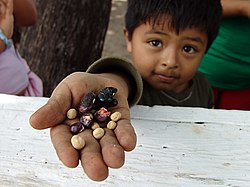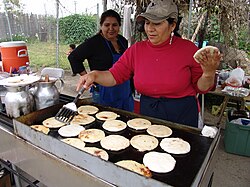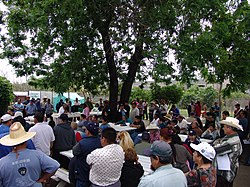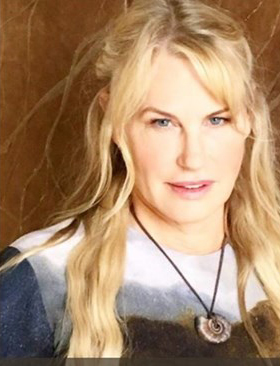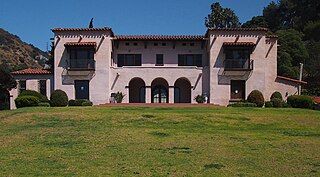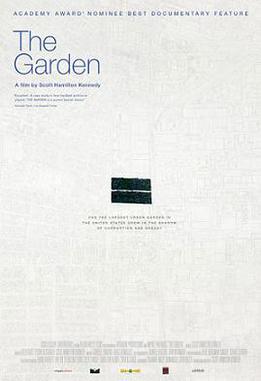History
Before the creation of the garden, the land belonged to nine different owners, the largest of which was Alameda-Barbara Investment Company, a real-estate firm which purchased its share in 1980. The company held 80% of the property that would become the urban garden. [2] The City of Los Angeles acquired the land by eminent domain in 1986, for the purpose of building a waste-to-energy facility known as the Los Angeles City Energy Recovery Project (LANCER). [3] The city paid $4,786,372 for the property. After Concerned Citizens of South Central Los Angeles, led by Juanita Tate, stopped the project in 1987, the land lay fallow. [4] [5]
The City sold the property to the L.A. Harbor Department in 1994 for use with the development of the Alameda Corridor. In July 1994 the Harbor Department granted a revocable permit to the L.A. Regional Food Bank – a private, nonprofit food-distribution network housed across the street from the site – to occupy and use the site as a community garden. [4]
The final order of condemnation under eminent domain included a right to repurchase the land for the largest landowner, Alameda-Barbara Investment Company, should the city sell it for non-public or non-housing purposes within ten years of the condemnation. In 2001, Ralph Horowitz, a partner in Alameda-Barbara sued the City for breach of contract, for failure to honor the original right of repurchase. The City denied his claim. [6]
In 2003, the City of L.A. settled with Horowitz, in a closed-door session. [6] The sale was for $5,050,000 [7] which was slightly above the $4.8 million the City had paid for it in the eminent domain seizure. The settlement was done to comply with the repurchase clause as the court had mandated. Horowitz agreed to donate 2.6 acres (11,000 m2) of the site, valued at nearly $3,000,000, for a public soccer field, as part of the settlement. The City Council discussed and approved the terms of the settlement in closed session. The South Central Farm's lawyer, Patrick Dunlevy, claims that despite repeated requests, negotiation documents relating to the session have never been released. [6]
Shortly thereafter the project was abandoned. In response the farmers formed an organization calling themselves the 'South Central Farmers Feeding Families'.
On January 8, 2004, Horowitz issued a notice to the gardeners setting February 29, 2004, as the termination date for the community garden. In response members of the South Central Farmers Feeding Families obtained legal counsel (Hadsell & Stormer, Inc., and Kaye, Mclane & Bednarski LLP) and filed a lawsuit seeking to invalidate the sale of the property. The Los Angeles County Superior Court issued a temporary restraining order and later a preliminary injunction halting development of the property until the lawsuit could be settled. The farmers lost the lawsuit and the court dissolved the injunction, freeing Horowitz to evict the farmers.
Initially, Horowitz sought $16.3 million for the property, more than three times the 1986 eminent domain valuation. In a deal brokered in cooperation by The Trust for Public Land, the SCF successfully raised a little over $6 million. [8] Fundraising efforts continued as farmers and celebrities began both a tree-sitting campaign and occupation of the land, while under the threat of forced eviction by the Los Angeles County Sheriff's Department. [9]
On June 7, 2006, the Annenberg Foundation announced that they would donate the money to buy the farm. Horowitz, however, did not respond to the offer, since it came after his May 22 deadline. [10]
At 3 a.m. on the morning of June 13, 2006, the Los Angeles County Sheriff's Department arrived at the farm, fully surrounding it by 4 a.m. At 5 a.m., the sheriffs entered the farm, giving the occupants 15 minutes to evacuate. At that point, most of the occupants of the land left, with a few verbal skirmishes reported. [11] According to the Los Angeles Times, more than 40 protesters were arrested. Actress Daryl Hannah was removed from the walnut tree in which she and another tree-sitter had been protesting the eviction and was arrested.
In June 2006, the farm was protected by a private security company hired by Horowitz to prevent members of the South Central Farm returning to squat on the land. Horowitz told the Los Angeles Times and KFI that he would not sell the land to them even if they offered him $100 million, because of the picketing of his house and anti-Semitic remarks directed towards him. [12]
On July 5, 2006, workers began bulldozing the farm amidst protest and acts of civil disobedience. One protester chained himself to a bulldozer and another lay down in front of a bulldozer. Both were arrested. Two others were also arrested, one for throwing a milk crate at a police officer and the other for assaulting a bulldozer driver. [13] Ten people were arrested in total.
On July 12, 2006, Judge Helen I. Bendix heard pre-trial arguments in a class-action suit filed by the farmers that the sale of the land to Horowitz "should be nullified on grounds that there was no prior public notice" of the transaction. The farmers' arguments were rejected on July 27, 2006 when Judge Bendix upheld the sale of the land to Horowitz. Dan Stormer, the attorney for the plaintiffs, said he would appeal. [14]
As of September 2008, Horowitz and Forever 21 were working on a proposal for a warehouse and distribution center on the now-bulldozed site. [15]
As of June 2011, the land remained an empty lot. [16] [17] In 2022, the city approved a project including warehouses and offices for the site. [18]

